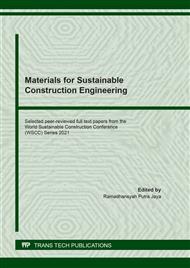[1]
H. M. Hamada, G. A. Jokhio, A. A. Al-attar, F. M. Yahaya, K. Muthusamy, A. M. Humada, Y. Gul, The use of palm oil clinker as a sustainable construction material : A review, Cem. Concr. Compos., 106 (2020) 103447.
DOI: 10.1016/j.cemconcomp.2019.103447
Google Scholar
[2]
N. Singh, M. Mithulraj, S. Arya, Influence of coal bottom ash as fine aggregates replacement on various properties of concretes: A review, Resour. Conserv. Recycl., 138 (2018) 257–271.
DOI: 10.1016/j.resconrec.2018.07.025
Google Scholar
[3]
M. A. Mannan., C. Ganapathy, Concrete from an agricultural waste-oil palm shell ( OPS ), Build. Environ., 39 (2004) 441–448.
DOI: 10.1016/j.buildenv.2003.10.007
Google Scholar
[4]
W. Zhai, J. Ding, X. An, Z. Wang, An optimization model of sand and gravel mining quantity considering healthy ecosystem in Yangtze River, China, J. Clean. Prod., 242 (2020) 118385.
DOI: 10.1016/j.jclepro.2019.118385
Google Scholar
[5]
Chen Shu-li, Wang Jian-lei, Xu Hong-wei, Di Jie, Li Zhi-ming, Effect of Sand Mining on Bridge Capacity and Safety under the Bridge, Journal of Highway and transportation Research and Development, Vol 2 (2), (2018).
DOI: 10.1061/jhtrcq.0000625
Google Scholar
[6]
S. R. Femmer, Instream gravel mining and related issues in Southern Missouri, USGS Fact Sheet, 012 (2002) 1–4.
DOI: 10.3133/fs01202
Google Scholar
[7]
B. S. Mohammed, W. L. Foo, M. Abdullahi, Flexural strength of palm oil clinker concrete beams, Mater. Des., 53 (2014) 325–331.
DOI: 10.1016/j.matdes.2013.07.041
Google Scholar
[8]
H. A. Ibrahim, H. A. Razak, Effect of palm oil clinker incorporation on properties of pervious concrete, Constr. Build. Mater., 115, (2016) 70–77.
DOI: 10.1016/j.conbuildmat.2016.03.181
Google Scholar
[9]
F. Abutaha, H. A. Razak, H. A. Ibrahim, H. H. Ghayeb, Adopting particle-packing method to develop high strength palm oil clinker concrete, Resour. Conserv. Recycl., 131 (2018) 247–258.
DOI: 10.1016/j.resconrec.2017.11.031
Google Scholar
[10]
J. Kanadasan, H. A. Razak, Mix design for self-compacting palm oil clinker concrete based on particle packing, Mater. Des., 56 (2014) 9–19.
DOI: 10.1016/j.matdes.2013.10.086
Google Scholar
[11]
K. Muthusamy, A. M. A. Budiea, S. M. Syed Mohsin, N. S. Muhammad Zam, N. E. Ahmad Nadzri, Properties of fly ash cement brick containing palm oil clinker as fine aggregate replacement,, Mater. Today Proc., no. xxxx, (2020).
DOI: 10.1016/j.matpr.2020.07.260
Google Scholar
[12]
R. Ahmmad, M. Z. Jumaat, U. J. Alengaram, S. Bahri, M. A. Rehman, H. Bin Hashim, Performance evaluation of palm oil clinker as coarse aggregate in high strength lightweight concrete, J. Clean. Prod, 112 (2016) 566–574.
DOI: 10.1016/j.jclepro.2015.08.043
Google Scholar
[13]
H. M. Hamada, F. M. Yahaya, K. Muthusamy, G. A. Jokhio, A. M. Humada, Fresh and hardened properties of palm oil clinker lightweight aggregate concrete incorporating Nano-palm oil fuel ash, Constr. Build. Mater, 214 (2019) 344–354.
DOI: 10.1016/j.conbuildmat.2019.04.101
Google Scholar
[14]
H. A. Ibrahim, H. Abdul Razak, F. Abutaha, Strength and abrasion resistance of palm oil clinker pervious concrete under different curing method, Constr. Build. Mater, 147 (2017) 576–587.
DOI: 10.1016/j.conbuildmat.2017.04.072
Google Scholar
[15]
F. Abutaha, H. Abdul Razak, J. Kanadasan, Effect of palm oil clinker (POC) aggregates on fresh and hardened properties of concrete, Constr. Build. Mater, 112 (2016) 416–423.
DOI: 10.1016/j.conbuildmat.2016.02.172
Google Scholar
[16]
BS EN 12390-3, Compressive strength of test specimens." (2001).
Google Scholar
[17]
BS 1881-122, Method for determination of water absorption,, (1983).
Google Scholar
[18]
G. Mailar, S. Raghavendra. N, B.M. Sreedhara, D.S. Manu, P. Hiremath, K. Jayakesh, "Investigation of concrete produced using recycled Aluminium dross for hot weather concreting conditions, Resour. Technol., 2 (2016) 68–80.
DOI: 10.1016/j.reffit.2016.06.006
Google Scholar
[19]
I. Yüksel, A. Genç, "Properties of concrete containing nonground ash and slag as fine aggregate, ACI Mater. J, 104 (2007) 397–403.
DOI: 10.14359/18829
Google Scholar
[20]
Y. Bai, F. Darcy, P. A. M. Basheer, Strength and drying shrinkage properties of concrete containing furnace bottom ash as fine aggregate, Constr. Build. Mater, 19 (2005) 691–697.
DOI: 10.1016/j.conbuildmat.2005.02.021
Google Scholar
[21]
L. B. Andrade, J. C. Rocha, M. Cheriaf, Evaluation of concrete incorporating bottom ash as a natural aggregates replacement, Waste Manag, 27 (2007) 1190–1199.
DOI: 10.1016/j.wasman.2006.07.020
Google Scholar
[22]
K. Muthusamy, R. Mohamad Hafizuddin, F. Mat Yahaya, M.A. Sulaiman, S.M. Syed Mohsin, N.N. Tukimat, R. Omar, S.C. Chin, Compressive strength performance of OPS lightweight aggregate concrete containing coal bottom ash as partial fine aggregate replacement,, IOP Conf. Ser. Mater. Sci. Eng., vol. 342, no. 1, (2018).
DOI: 10.1088/1757-899x/342/1/012099
Google Scholar
[23]
A.M. Neville, Properties of Concrete, 5th Ed., Pearson Education Ltd, (2012).
Google Scholar
[24]
R. Siddique, Compressive strength, water absorption, sorptivity, abrasion resistance and permeability of self-compacting concrete containing coal bottom ash, Constr. Build. Mater, 47 (2013) 1444–1450.
DOI: 10.1016/j.conbuildmat.2013.06.081
Google Scholar
[25]
E. Baite, A. Messan, K. Hannawi, F. Tsobnang, W. Prince, Physical and transfer properties of mortar containing coal bottom ash aggregates from Tefereyre (Niger), Constr. Build. Mater, 125 (2016) 919–926.
DOI: 10.1016/j.conbuildmat.2016.08.117
Google Scholar
[26]
V. Zivica, A. Bajza, Acidic attack of cement based materials - A review. Part 1. Principle of acidic attack, Constr. Build. Mater, 15 (2001) 331–340.
DOI: 10.1016/s0950-0618(01)00012-5
Google Scholar
[27]
ACI 318R-89. (1989). Building code requirements for reinforced concrete (ACI 318-89) and commentary--ACI 318R-89.
DOI: 10.1016/0262-5075(85)90031-4
Google Scholar


